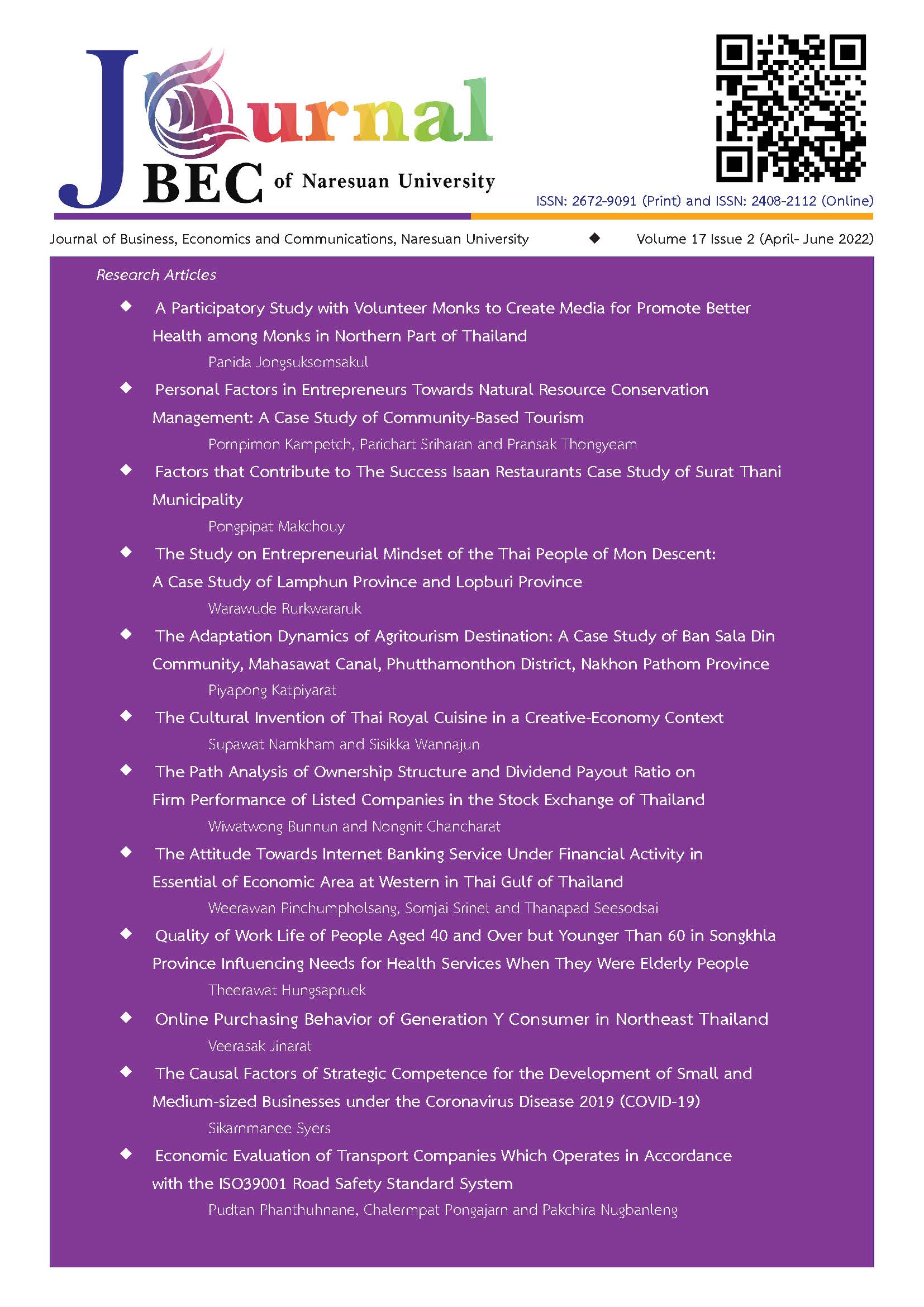Personal Factors in Entrepreneurs Towards Natural Resource Conservation Management: A Case Study of Community-Based Tourism
Main Article Content
Abstract
This study is a quantitative research, and the objective is to compare personal factors affecting the conservation of natural resources. The population and sampling is members of the community-based tourism group in Thailand. Because the exact number of population is unknown, researchers determined the size according to the formula developed by Cochran (1953). The level of confidence is 95% and the error level is 5%. The researcher then determined the number of suitable samples for the research which is 385 people.
The results of the research showed that the different levels of members’ education and income, and their membership duration differently affect the level of conservation in operating the community-based tourism namely in terms of; i) the beneficial utilization of the resources, ii) the activities which promote and raise awareness in resource conservation, iii) penalties for those who's destroying resources in the community, iv) the restoration, rehabilitation and improvement of resources to maintain their original condition, and v) the pursuit of additional resources, all of these at the statistical significance level of .05.
Article Details

This work is licensed under a Creative Commons Attribution-NonCommercial-NoDerivatives 4.0 International License.
References
Boonyarat, B. (2015). The Factors affecting Behavior on Natural and Environmental Conservation of people in border Thai - LAO PDR. Journal of Social Academic, 7(2), 1-8.
Bejranonda, S. (2010). Environmental Economics. Bangkok: Kasetsart University Press.
Choomanee, T. (2014). Pred Nai community tambon Huang Nam Kao Trat province. Public Aad Private Management. Burapha University, Chonburi.
Churak, Y. and Chuchuay, P. (2015). The Role Participation in the Conservation of Natural Resources Wildlife Area Mountains Line Amphoe Tamot Phatthalung Province. The 6th Hatyai National Conference, Hatyai University. 769-784.
Chuckpaiwong, R. and Virunraj, B. (2020). Characteristics of Successful Entrepreneurs for Thailand 4.0: Thailand Medium Enterprises in Agricultural Processing Business. Journal of Innovation Technology Management, 7(1), 118-127.
Cochran, W. G. (1953). Sampling techniques. New York: John Wiley and Sons. Inc.
Dasmann, R. F. (1976). Environmental Conservation. New York: John Wiley and Sons.
Designated Areas for Sustainable Tourism. (2019). Community based Tourism: How to be sustainable. Retrieved March 12, 2021, from https://tis.dasta.or.th/dastaknowledge/cbt-howtobecomesustainable-thai
Dowruang, S. (2018). Organization citizenship behavior for the environment: The spillover effects of private lifestyle on work-life. Master thesis, B. A., Silpakorn University, Bangkok.
Jankaew, K. (2001). Environmental science. Bangkok: Kasetsart University Press.
Kampetch, P and Jitpakdee, R. (2019). Innovation and Creativity in Community-Based Tourism Management. Journal of Business, Economics and Communications, 14(1), 108-121.
Ministry of Tourism and Sports, (2019). Action Plan to Drive Sustainable and Creative Community Based Tourism Development. Retrieved March 12, 2021, from http://www.oic.go.th/FILEWEB/CABINFOCENTER17/DRAWER021/GENERAL/DATA0000/00000334.PDF
Mahatean, J. (2016). Natural Resources and Environment Management. Journal of Educational Review Faculty of Education in MCU. 3(2), 129-141.
Niesenbaum, R. (2019). The Integration of Conservation, Biodiversity, and Sustainability. Sustainability, 11(2019), 4676.
Peuchnog, P., Bunjongsiri, S. and Keowan, B. (2016). Agro-Tourism Management by Community in Ku KaSing Sub District, Kasetwisai District, Roi-Et Province. The 3rd STOU Graduate Research Conference.
Pimonsompong, C. (2017). Tourism Research: Principle to Practice in Social Reflective Perspective. Journal of Business, Economics and Communications, 12(1), 1-5.
Pongsakornrungsilp, P. (2014). The Management of Sustainable Community-Based Tourism: The Case of Ban Kokekrai, PhangNga Province. Veridian E-Journal, 7(3), 650-665.
Richards, G. and Wilson, J. (2006). Developing creativity in tourist experiences: a solution to the serial reproduction of culture?. Tourism Management, 27(2006), 1408-1413.
Ruangpanit, N. (1995). Tropical seasonal forests in monsoon Asia: With emphasis on continental southeast Asia. Vegetation, 121(1995), 31-40.
Ruangpanich, N. (2003). Conservation of Natural Resources and Environment. Fourth Edition, Bangkok: Kasetsart University Press.
Sarobon, S. and Wongtabtim, U. (2003). Community-based tourism Conceptualized and Experienced from North Thailand. Chiang Mai: Vanida Press.
Sinthipong, U. (2015). Local Community and the Participation in the Management of Natural Resources for Sustainable Use. Executive Journal, 35(1), 104-113.
Soonthonwaritthichod, N. and Sukhaboon, K. (2013). Alternative: A study of environmental problems in the district, three graduates: Factors affecting the development of natural resources and environment of the people of the Third District graduates. Phranakhon Si Ayutthaya Rajabhat University, Ayutthaya.
Sriharun, P. and Kampetch, P. (2018). Community Tourism: A New Alternative to Sustainability. Dusit Thani College Journal, 12(3), 118-132.
Suansri, P. (2003). Manual of Community-Based Tourism Management. Bangkok: Travel for Life Project.
Surya, B., Syafri, S., Sahban, H. and Sakti, H. S. (2020). Natural Resource Conservation Based on Community Economic Empowerment: Perspectives on Watershed Management and Slum Settlements in Makassar City, South Sulawesi, Indonesia. Land, 9(104), 1-31.
Tepsing, P and Promsaka Na Sakolnakorn, T. (2013). Community improvement guidelines for Sustainable development. Humanities and Social Sciences, Khon Kaen University, 30(2), 43-64.


